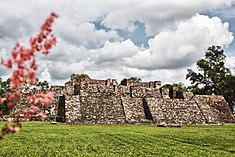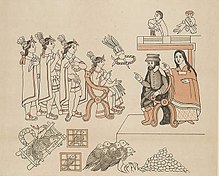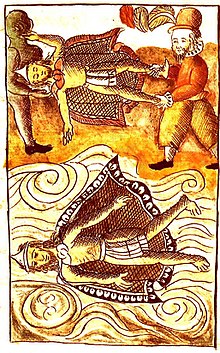
A | B | C | D | E | F | G | H | CH | I | J | K | L | M | N | O | P | Q | R | S | T | U | V | W | X | Y | Z | 0 | 1 | 2 | 3 | 4 | 5 | 6 | 7 | 8 | 9
| Spanish conquest of the Aztec Empire | |||||||||
|---|---|---|---|---|---|---|---|---|---|
| Part of the Spanish colonization of the Americas and Mexican Indian Wars | |||||||||
 Conquest of Mexico by Cortés, oil on canvas[2] Spanish: Conquista de México por Cortés | |||||||||
| |||||||||
| Belligerents | |||||||||
Indigenous allies:
Support or occasional alliesb: |
Allied city-states: Independent kingdoms and city-states:
| ||||||||
| Commanders and leaders | |||||||||
|
Spanish commanders:
Indigenous allies:
|
Aztec commanders:
| ||||||||
| Strength | |||||||||
|
Spaniards (total):
~10,000 Totonac (~8,400 followed Cortés from Cempoala) and high number of other indigenous allies | |||||||||
| Casualties and losses | |||||||||
|
1,800 Spaniards dead[3] Tens of thousands of Tlaxcaltecs and indigenous allies dead[citation needed] |
200,000 Aztecs dead (including civilians)[4]
Unknown casualties of other natives 15 Spaniards dead, many wounded at the Battle of Cempoala (1520) | ||||||||
| |||||||||
 |
| Aztec civilization |
|---|
| Aztec society |
| Aztec history |
The Spanish conquest of the Aztec Empire was a pivotal event in the history of the Americas, marked by the collision of the Aztec Triple Alliance and the Spanish Empire, ultimately reshaping the course of human history. Taking place between 1519 and 1521, this event saw the Spanish conquistador Hernán Cortés, and his small army of soldiers and indigenous allies, overthrowing one of the most powerful empires in Mesoamerica.
Led by the Aztec ruler Moctezuma II, the Aztec Empire had established dominance over central Mexico through military conquest and intricate political alliances. A combination of factors including superior weaponry, strategic alliances with oppressed indigenous groups, and the impact of European diseases contributed to the downfall of the short rule of the Aztec civilization.
The conquest of Tenochtitlán, the capital of the Aztec Empire, marked the beginning of Spanish dominance in the region and the establishment of New Spain. This conquest had profound consequences, as it led to the cultural assimilation of the Spanish culture, while also paving the way for the emergence of a new social hierarchy dominated by Spanish conquerors and their descendants.
Significant events in the conquest of Mesoamerica
Following an earlier expedition to Yucatán led by Juan de Grijalva in 1518, Spanish conquistador Hernándo Cortés led an expedition (entrada) to Mexico. The next year, Cortés and his retinue set sail for Mexico.[7] The Spanish campaign against the Aztec Empire had its final victory on 13 August 1521, when a coalition army of Spanish forces and native Tlaxcalan warriors led by Cortés and Xicotencatl the Younger captured the emperor Cuauhtémoc and Tenochtitlan, the capital of the Aztec Empire. The fall of Tenochtitlan marks the beginning of Spanish rule in central Mexico, and they established their capital of Mexico City on the ruins of Tenochtitlan.
Cortés made alliances with tributary city-states (altepetl) of the Aztec Empire as well as their political rivals, particularly the Tlaxcaltecs and Tetzcocans, a former partner in the Aztec Triple Alliance. Other city-states also joined, including Cempoala and Huejotzingo and polities bordering Lake Texcoco, the inland lake system of the Valley of Mexico. Particularly important to the Spanish success was a multilingual (Nahuatl, a Maya dialect, and Spanish) Nahua-speaking woman enslaved by the Mayas, known to the Spanish conquistadors as Doña Marina, and later as La Malinche. After eight months of battles and negotiations, which overcame the diplomatic resistance of the Aztec Emperor Moctezuma II to his visit, Cortés arrived in Tenochtitlan on 8 November 1519, where he took up residence with fellow Spaniards and their indigenous allies. When news reached Cortés of the death of several of his men during the Aztec attack on the Totonacs in Veracruz, Cortés claims that he took Motecuhzoma captive. Capturing the cacique or indigenous ruler was a standard operating procedure for Spaniards in their expansion in the Caribbean, so capturing Motecuhzoma had considerable precedent but modern scholars are skeptical that Cortés and his countrymen took Motecuhzoma captive at this time. They had great incentive to claim they did, owing to the laws of Spain at this time, but critical analysis of their personal writings suggest Motecuhzoma was not taken captive until a much later date.[8]
When Cortés left Tenochtitlan to return to the coast and deal with the threat of the expedition of Pánfilo de Narváez, Cortés left Pedro de Alvarado in charge of Tenochtitlan. Cortés left with a small army to the coast with the plan of attacking during the night. After defeating Narváez's fleet, Cortés convinced most of his enemy's crew to go with him by promising great riches. Upon reaching Tenochtitlan, Cortés and the new enlarged force received the message that "the Aztec had risen against the Spanish garrison" during a religious celebration.[9] Alvarado ordered his army to attack the unarmed crowd; he later claims that the Aztecs had used the celebration to cover up a counterattack. Cortés realized that the defeat was imminent and decided to escape yet, the Aztecs attacked. The Massacre is most known as La Noche Triste (the sorrowful night) about "400 Spaniards, 4000 native allies and many horses before reaching the mainland".[9] Moctezuma was killed, although the sources do not agree on who killed him.[10] According to one account, when Moctezuma, now seen by the population as a mere puppet of the invading Spaniards, attempted to calm the outraged populace, he was killed by a projectile.[11] According to an indigenous account, the Spanish killed Moctezuma.[12]
The Spanish, Tlaxcalans and reinforcements returned a year later on 13 August 1521 to a civilization that had been weakened by famine and smallpox. This made it easier to conquer the remaining Aztecs.[13] The Spaniards' victory is attributed to their help from indigenous allies, technology, and the Aztec empire's vulnerability due to the smallpox spread. As a result, the Aztec's tactics countering the Spaniard's advanced technology is understated. According to Hassig, "It is true that cannons, guns, crossbows, steel blades, horses and war dogs were advanced on the Aztecs' weaponry. But the advantage these gave a few hundred Spanish soldiers was not overwhelming."[14] In the words of Restall, "Spanish weapons were useful for breaking the offensive lines of waves of indigenous warriors, but this was no formula for conquest ... rather, it was a formula for survival, until Spanish and indigenous reinforcements arrived."[15] The integration of the indigenous allies, essentially, those from Tlaxcala and Texcoco, into the Spanish army played a crucial role in the conquest, yet other factors paved the path for the Spaniards' success. For instance, the Spaniards' timing of entry, the compelling ideologies of both groups, and the Spanish unfamiliarity with the Aztec Empire. Therefore, the Spaniards lacked a sense of danger and power structure within the empire. "A direct attack on a city as mighty as Tenochtitlan was unlikely and unexpected" from the enemy empires. As well, it was very uncommon that an attacking army would come unannounced.[14] In addition, aside from the infantry and the allies' role in the Spanish conquest, cavalry was the "arm of decision in the conquest" and "the key ingredient in the Spanish forces".[16]
Many of those on the Cortés expedition of 1519 had never seen combat before, including Cortés. A whole generation of Spaniards later participated in expeditions in the Caribbean and Tierra Firme (Central America), learning strategy and tactics of successful enterprises. The Spanish conquest of Mexico had antecedents with established practices.[17]
The fall of the Aztec Empire was the key event in the formation of the Spanish Empire overseas, with New Spain, which later became Mexico.
Timeline
- 1428 – Creation of the Triple Alliance of Tenochtitlan, Texcoco, and Tlacopan
- 1492–93 – Columbus reaches the Caribbean; start of permanent Spanish settlements
- 1493–1515 – Spanish exploration, conquest, enslavement, and settlement in the Caribbean and the Spanish Main
- 1502 – Moctezuma II elected huey tlatoani, emperor of the Aztec Triple Alliance
- 1503–09 – Moctezuma's coronation conquests
- 1504 – Hernan Cortés arrives in the Caribbean
- 1511– Spanish viceroy in the Caribbean appoints Diego Velázquez to conquer and govern Cuba
- 1510~ Francisco Vazquez de Coronado was born
- 1515 – Texcocan monarch Nezahualpilli dies; Cacamatzin succeeds to the throne; the rebellion of Ixtlilxochitl
- 1517 – Expedition of Francisco Hernández de Córdoba to the Yucatán coast
- 1517- City of Cholollan secedes from Tlaxcalteca Alliance, becomes a tributary state of the Aztec Triple Alliance
- 1518 – Expedition of Juan de Grijalva to the Yucatán and Gulf coasts; appointment of Cortés to lead a third exploratory expedition
1519

- 10 February – Cortés expedition leaves Cuba, taking Hernández de Córdoba's route. In the process, Cortés ignores Velásquez's cancellation of the expedition
- Early 1519 – Gerónimo de Aguilar, shipwrecked Spaniard, bilingual in Yoko Ochoko, joins Cortés

- 24 March – Leaders of Potoncan sue Spaniards for peace and gift the Spaniards, 20 slave women. One of the enslaved Nahua woman (known as La Malinche, Doña Marina, Malintze, and Malintzin), is multilingual and will serve as one of the main translators for the expedition.[18]
- 21 April – Expedition lands in the Gulf coast near San Juan de Ullúa[19]
- Early June – Cortés establishes the colony of Villa Rica de la Vera Cruz and relocates the company to a beach near the settlement of Quiahuiztlan.[20] Afterward, the Spaniards travel to Cempoala[19] and formalize an alliance with Xicomecoatl (also known as the Fat Chief and Cacique Gordo),[21] the leader of Cempoala. At this time, Cempoala is the capital of the Totonac confederacy.
- July/August – Cortés' soldiers desecrate Cempoala [22]
- 16 August – Spaniards and Totonac allies embark on march toward the Valley of Tenochtitlan, passing Citlatapetl and many other notable geographic landmarks like Cofre de Perote[23]
- 31 August – Tlaxcalteca attack Spaniards after entering the territory of Tlaxcallan. They succeed in killing two horsemen.[24]
- September – Tlaxcalteca assault the Spanish camp by day, and the Spanish respond by raiding unarmed Tlaxcalteca towns and villages by night. Tlaxcallan brokers a peace after 18 punishing days of war, by which point the Spaniards had lost half their cavalry and 1/5 their men.[25][26][15]
- October – March to Cholula. Conquistadors massacre unarmed Cholulans, then Spanish-Tlaxcala combine forces to sack Cholollan, and replace Cholulan political leadership with Tlaxcallan-favoring nobles. The massacre broke out for disputed reasons, perhaps to quash an impending Cholulan attack[27] or to fulfill a Tlaxcalteca plan to both exact revenge on Cholollan for its secession and to test their new Spanish allies.[15]
- 8 November 1519 – Meeting of Cortés and Moctezuma
1520

- April or May – Pánfilo de Narváez arrives on the Gulf coast, sent by Governor Velázquez to rein in Cortés
- Mid-May – Pedro de Alvarado massacres Aztec elites celebrating the Festival of Toxcatl
- Late May – Cortés forces attack Narvárez's forces at Cempoala; incorporation of those Spaniards into Cortés's forces
- 24 June – Spanish forces return to Tenochtitlan
- Late June – Uprising in Tenochtitlan; the death of Moctezuma in unclear circumstances, perhaps killed by the Spaniards, perhaps by his own people; deaths of other leaders of the Triple Alliance
- 30 June – "La Noche Triste" – Evacuation of Spanish-Tlaxcalteca allied forces from Tenochtitlan; deaths of perhaps 1,000 Spaniards and 1,000 Tlaxcalans
- 9 or 10 July – Battle of Otumba, Aztec forces attack the Spanish-Tlaxcalteca forces at Otumba
- 11 or 12 July – Retreat to Tlaxcala
- 1 August – Spanish punitive expedition in Tepeaca in reprisal for the murder of Spaniards by its inhabitants.[28]
- Mid-September – Coronation of Cuitlahuac as Moctezuma's successor
- Mid-October to mid-December – Smallpox epidemic; death of Cuitlahuac on 4 December, perhaps of smallpox
- Late December – Spanish-Tlaxcaltec forces return to the Valley of Mexico; join with Texcoca forces of Ixtlilxochitl
1521

- Late January – Cuauhtemoc elected huey tlatoani of Tenochtitlan
- February – Combined Spanish-Tlaxcalteca-Texcoca forces attack Xaltocan and Tlacopan; Texcoco becomes the base of operations for the campaign against Tenochtitlan
- Early April – Attacks against Yautepec and Cuernavaca, following by sacking
- Mid-April – Combined forces defeated by the Xochimilcans, Tenochtitlan's ally
- Late April – Construction of 13 shallow-bottomed brigantines by Tlaxcalteca laborers under Spanish supervision; mounted with cannon; launched into Lake Texcoco, allowing Spanish control of the inland sea
- 10 May – Start of the siege of Tenochtitlan; potable water from Chapultepec cut off
- 30 June – Defeat of Spanish-Tlaxcalteca forces on a causeway; capture and ritual sacrifice of the Spaniards and their horses in Tenochtitlan
- July – Spanish ships land at Veracruz with large numbers of Spaniards, munitions, and horses
- 20–25 July – Battle for Tenochtitlan
- 1 August – Spanish-Tlaxcalan-Texcocan forces enter the Plaza Mayor; last stand of the Aztec defenders
- 13 August – Surrender of Aztec defenders; capture of Cuauhtemoc
- 13–17 August – Wholesale sacking and violence against the survivors in Tenochtitlan
1522
- October – Charles V, Holy Roman Emperor names Cortés captain-general of New Spain, the Spanish name for central Mexico.
- November – Death of Cortés's wife, Catalina Suárez, in Coyoacan, where Cortés was resident while the new capital Mexico City was constructed on the ruins of Tenochtitlan
- Cortés's Second Letter to the crown is published in Seville, Spain
1524
- Arrival of the first twelve Franciscan missionaries to Mexico, beginning of the "spiritual conquest" to convert the indigenous populations to Christianity[29]
- Conqueror Cristóbal de Olid's expedition to Honduras; renounces Cortés' authority; Cortés expedition to Honduras with the captive Cuauhtemoc
1525
- February – execution of the three rulers of the former Triple Alliance, including Cuauhtemoc
- Don Juan Velázquez Tlacotzin, former "viceroy" (cihuacoatl) appointed governor of the indigenous sector of Mexico City
1525–30
Zdroj:https://en.wikipedia.org?pojem=Spanish_conquest_of_Mexico
Text je dostupný za podmienok Creative Commons Attribution/Share-Alike License 3.0 Unported; prípadne za ďalších podmienok. Podrobnejšie informácie nájdete na stránke Podmienky použitia.
Antropológia
Aplikované vedy
Bibliometria
Dejiny vedy
Encyklopédie
Filozofia vedy
Forenzné vedy
Humanitné vedy
Knižničná veda
Kryogenika
Kryptológia
Kulturológia
Literárna veda
Medzidisciplinárne oblasti
Metódy kvantitatívnej analýzy
Metavedy
Metodika
Text je dostupný za podmienok Creative
Commons Attribution/Share-Alike License 3.0 Unported; prípadne za ďalších
podmienok.
Podrobnejšie informácie nájdete na stránke Podmienky
použitia.
www.astronomia.sk | www.biologia.sk | www.botanika.sk | www.dejiny.sk | www.economy.sk | www.elektrotechnika.sk | www.estetika.sk | www.farmakologia.sk | www.filozofia.sk | Fyzika | www.futurologia.sk | www.genetika.sk | www.chemia.sk | www.lingvistika.sk | www.politologia.sk | www.psychologia.sk | www.sexuologia.sk | www.sociologia.sk | www.veda.sk I www.zoologia.sk
